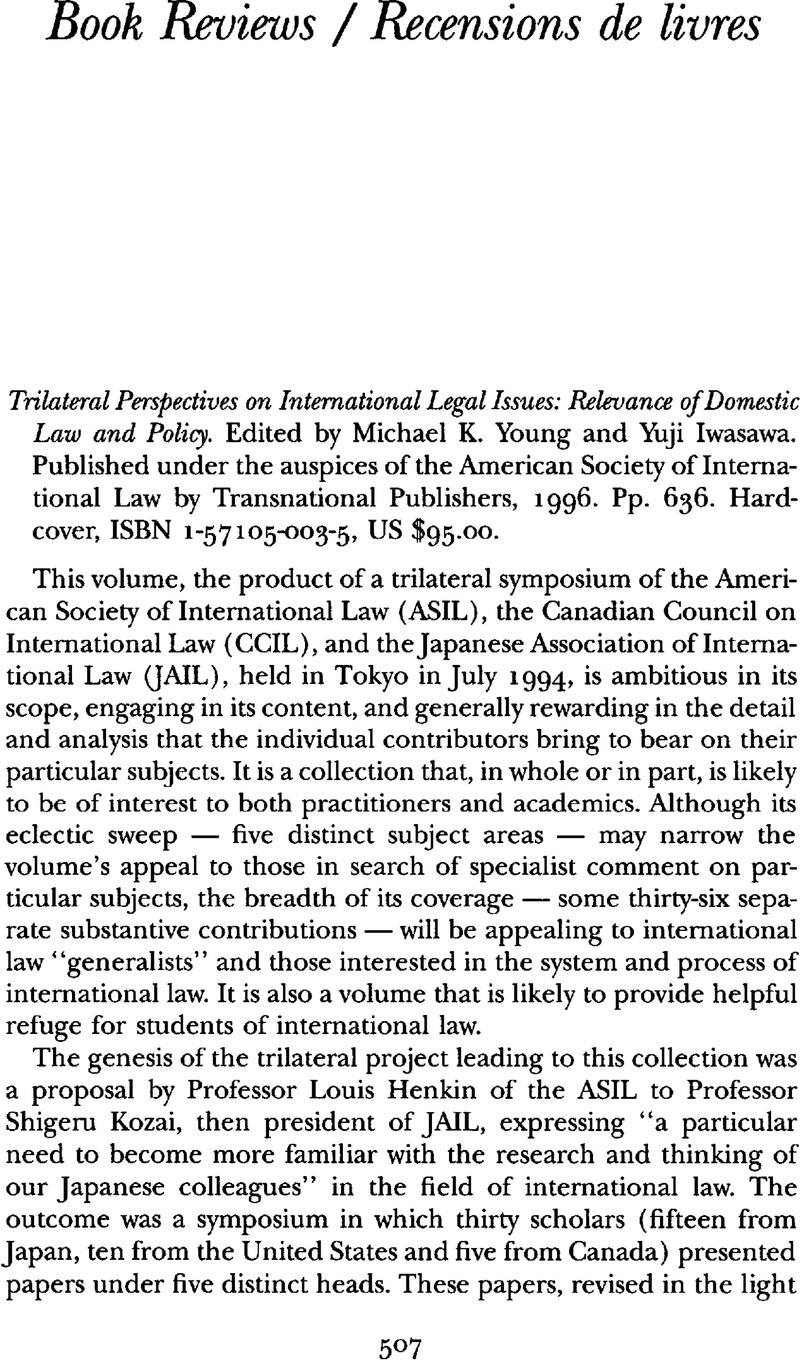No CrossRef data available.
Published online by Cambridge University Press: 09 March 2016

1 “International Lawmaking in the Context of the Law of the Sea and the Global Environment” at 13–26.
2 “International Lawmaking Process in Transition? A Comparative and Critical Analysis of Recent International Norm-making Process” at 27–45.
3 “Methods of Regulation for Global Environmental Protection: A Reappraisal of International Lawmaking” at 47–60.
4 “Review of Treaty Negotiating Procedures for International Lawmaking: Lessons from UNCLOS III” at 61–71.
5 “International Environmental and Human Rights Law: The Role of Soft Law in the Evolution of Procedural Rights to Information, Participation in Decision-making, and Access to Domestic Remedies in Environmental Matters” at 73–94.
6 “International Environmental Law in Transition” at 95–107.
7 “Projecting Beyond the Boundaries: A Canadian Perspective on the Double-edged Sword of Extraterritorial Acts” at 119–48.
8 “Extraterritoriality and International Law” at 149–64.
9 “Extraterritorial Jurisdiction of Antitrust Law in International Law” at 165–75.
10 “Extraterritoriality and U.S. Foreign Trade Controls: Lessons from Old Disputes and Sources of Potential New Problems” at 177–98.
11 “Rethinking the Conceptual Framework of Extraterritorial Issues and the Methods for Resolving Conflicts” at 199–212.
12 “Private Law Effects of Foreign Export Control Laws with Extraterritorial Reach” at 213–24.
13 “The Resolution of Disputes between Japan and Canada and the United States: A Modest Proposal” at 235–48.
14 “The Structural Impediments Initiatives: A Model for Dealing with International Economic Frictions” at 249–62.
15 “Reflections on Problems of International Economic Relations” at 263–81.
16 “Economic Relations between Japan and North America: A Challenge to the International Legal System” at 283–98.
17 “Japanese Law and Policy for Globalization of Industry and the Corporation: Measures for Relief from Investment and Trade Frictions” at 299-312.
18 “Fairness, Reciprocity, and Retaliation after the WTO: Section 301 of the U.S. Trade Act of 1974” at 313–26.
19 “Recent Development in the International Court of Justice” at 337–61.
20 “Transnationalism and the Settlement of Disputes: The Role of Nonstate Actors” at 363–76.
21 “Settlement of Disputes Concerning the WTO Agreement: Various Means Other than Panel Procedures” at 377–402.
22 “WTO Rules and Procedures for the Settlement of Disputes — Their Formation: A Practitioner’s View” at 403–17.
23 “Supplemental Procedural Rules of International Non-Judicial Proceedings” at 419–29.
24 “International Dispute Resolution: Lessons from Malta” at 431–50.
25 “The Travail of a Middle-Aged Peacekeeper: Canada and the New Challenges of Peacekeeping” at 461–74.
26 “The Security Council Unleashed? Post-Cold War U.N. Peacekeeping and Prospects of U.S. Participation” at 475–94.
27 “United Nations’ Activities for Peace and the Constitution of Japan” at 495–522.
28 Japanese War Guilt, the “Peace Constitution,” and Japan’s Role in Global Peace and Security” at 523–46.
29 “The United Nations and NATO: The Limits of Cooperation between International Organizations” at 547–65.
30 “Japan’s Legal Framework for Peacekeeping Operations and International Humanitarian Relief Operations” at 567–79.
31 -At 538.